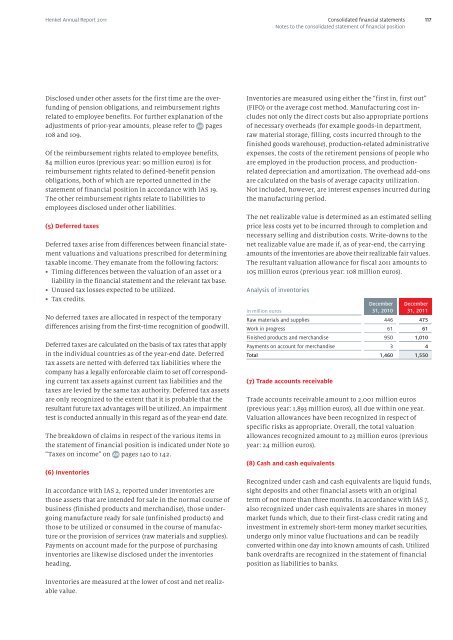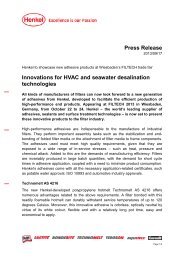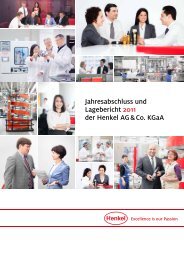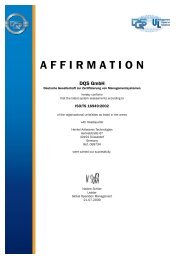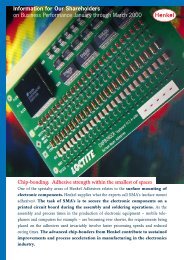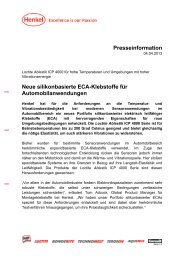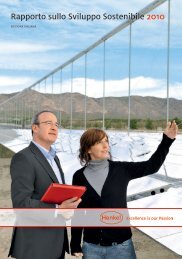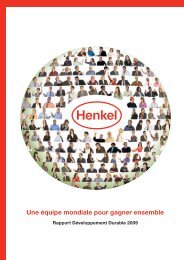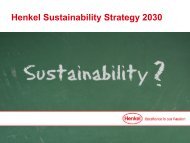Henkel Annual Report 2011 - Henkel AG & Co. KGaA Annual Report ...
Henkel Annual Report 2011 - Henkel AG & Co. KGaA Annual Report ...
Henkel Annual Report 2011 - Henkel AG & Co. KGaA Annual Report ...
Create successful ePaper yourself
Turn your PDF publications into a flip-book with our unique Google optimized e-Paper software.
<strong>Henkel</strong> <strong>Annual</strong> <strong>Report</strong> <strong>2011</strong><br />
Disclosed under other assets for the first time are the overfunding<br />
of pension obligations, and reimbursement rights<br />
related to employee benefits. For further explanation of the<br />
adjustments of prior-year amounts, please refer to pages<br />
108 and 109.<br />
Of the reimbursement rights related to employee benefits,<br />
84 million euros (previous year: 90 million euros) is for<br />
reimbursement rights related to defined-benefit pension<br />
obligations, both of which are reported unnetted in the<br />
statement of financial position in accordance with IAS 19.<br />
The other reimbursement rights relate to liabilities to<br />
employees disclosed under other liabilities.<br />
(5) Deferred taxes<br />
Deferred taxes arise from differences between financial statement<br />
valuations and valuations prescribed for determining<br />
taxable income. They emanate from the following factors:<br />
• Timing differences between the valuation of an asset or a<br />
liability in the financial statement and the relevant tax base.<br />
• Unused tax losses expected to be utilized.<br />
• Tax credits.<br />
No deferred taxes are allocated in respect of the temporary<br />
differences arising from the first-time recognition of goodwill.<br />
Deferred taxes are calculated on the basis of tax rates that apply<br />
in the individual countries as of the year-end date. Deferred<br />
tax assets are netted with deferred tax liabilities where the<br />
company has a legally enforceable claim to set off corresponding<br />
current tax assets against current tax liabilities and the<br />
taxes are levied by the same tax authority. Deferred tax assets<br />
are only recognized to the extent that it is probable that the<br />
resultant future tax advantages will be utilized. An impairment<br />
test is conducted annually in this regard as of the year-end date.<br />
The breakdown of claims in respect of the various items in<br />
the statement of financial position is indicated under Note 30<br />
“Taxes on income” on pages 140 to 142.<br />
(6) Inventories<br />
In accordance with IAS 2, reported under inventories are<br />
those assets that are intended for sale in the normal course of<br />
business (finished products and merchandise), those undergoing<br />
manufacture ready for sale (unfinished products) and<br />
those to be utilized or consumed in the course of manufacture<br />
or the provision of services (raw materials and supplies).<br />
Payments on account made for the purpose of purchasing<br />
inventories are likewise disclosed under the inventories<br />
heading.<br />
Inventories are measured at the lower of cost and net realizable<br />
value.<br />
<strong>Co</strong>nsolidated financial statements<br />
Notes to the consolidated statement of financial position<br />
Inventories are measured using either the “first in, first out”<br />
(FIFO) or the average cost method. Manufacturing cost includes<br />
not only the direct costs but also appropriate portions<br />
of necessary overheads (for example goods-in department,<br />
raw material storage, filling, costs incurred through to the<br />
finished goods warehouse), production-related administrative<br />
expenses, the costs of the retirement pensions of people who<br />
are employed in the production process, and production-<br />
related depreciation and amortization. The overhead add-ons<br />
are calculated on the basis of average capacity utilization.<br />
Not included, however, are interest expenses incurred during<br />
the manufacturing period.<br />
The net realizable value is determined as an estimated selling<br />
price less costs yet to be incurred through to completion and<br />
necessary selling and distribution costs. Write-downs to the<br />
net realizable value are made if, as of year-end, the carrying<br />
amounts of the inventories are above their realizable fair values.<br />
The resultant valuation allowance for fiscal <strong>2011</strong> amounts to<br />
105 million euros (previous year: 108 million euros).<br />
Analysis of inventories<br />
December December<br />
in million euros<br />
31, 2010 31, <strong>2011</strong><br />
Raw materials and supplies 446 475<br />
Work in progress 61 61<br />
Finished products and merchandise 950 1,010<br />
Payments on account for merchandise 3 4<br />
Total 1,460 1,550<br />
(7) Trade accounts receivable<br />
Trade accounts receivable amount to 2,001 million euros<br />
(previous year: 1,893 million euros), all due within one year.<br />
Valuation allowances have been recognized in respect of<br />
specific risks as appropriate. Overall, the total valuation<br />
allowances recognized amount to 23 million euros (previous<br />
year: 24 mil lion euros).<br />
(8) Cash and cash equivalents<br />
Recognized under cash and cash equivalents are liquid funds,<br />
sight deposits and other financial assets with an original<br />
term of not more than three months. In accordance with IAS 7,<br />
also recognized under cash equivalents are shares in money<br />
market funds which, due to their first-class credit rating and<br />
investment in extremely short-term money market securities,<br />
undergo only minor value fluctuations and can be readily<br />
converted within one day into known amounts of cash. Utilized<br />
bank overdrafts are recognized in the statement of financial<br />
position as liabilities to banks.<br />
117


